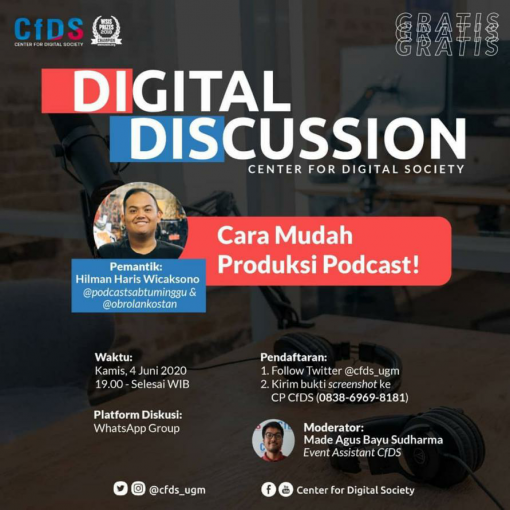
Yogyakarta, June 4th, 2020—Center for Digital Society (CfDS) brought the topic of podcast production in the last Digital Discussion. Through the title “The Easy Way to Podcast Production!” The 22nd Digital Discussion invited Hilman Haris Wicaksono from Podcast Sabtu Minggu and Obrolan Kostan as the speaker.
Half an hour before the discussion started, the moderator, Made Agus Bayu Sudharma as the CfDS event assistant reminded the participants that the discussion would begin shortly. At exactly 19.00 WIB, the moderator began the discussion by introducing himself and conveying the discussion rules. After the speakers introduced himself, the moderator asked about the participants’ reasons in the discussion—as podcast listeners—were interested in listening to the podcast until it was finished. This question has also become the kick-start of the discussion by Hilman.
Hilman explained that he believed that original content must have its own audience. Therefore, consistency and choice of the main topics of a podcast can be the key to the listener’s interest. Hilman then started delivering the core material by first explaining his background, which is then followed by the meaning of the podcast.
Podcasts are literally an acronym of iPod broadcast. However, in Indonesian, podcasts are equivalent to “siniar”. Podcasts can be interpreted as audio-based digital content in many ways, such as interviews, monologues, audiobooks, and even live events. With an eye to start producing podcasts simply, all you need is a recording tool and a post-production application. The recording tool can be as simple as using a smartphone. However, if it is possible for you to buy additional equipment, you can use an H4N zoom or Sony recorder. Hilman explained, for professional purposes such as branded content or advertisements from clients, of course, need additional tools such as microphone extension and mixer that are useful for producing better audio.
“By using a smartphone, one can already produce podcasts, because of the basis of a podcast is the recording process and all smartphones must have provided a recording feature,” Hilman explained. Of course, there are specific procedures to be done when we do smartphone recording. The most important procedure is to avoid recording outside the room or in the crowd because there will be a lot of disturbing noises recorded, so the recording process is better fone alone or in an empty place. In addition, to reduce noise when doing smartphone recording, you can wrap the smartphone using an additional cloth or a simple damper.
After the recording session, the next step in making a podcast is editing—which can be done via mobile. The purpose of the podcast content editing process is basically only three: add a bumper, cut or discard unwanted parts, and clean up the noise recorded. The good news, these three processes are available in Anchor.fm platform or application. In comparison, Anchor.fm is like Canva in the design world. One can argue that Anchor.fm in terms of features is way simple than Adobe Audition or GarageBand, but still proper for mere use in editing podcast content.
Moreover, Hilam conveyed the methods and conditions to upload a podcast to music platforms such as Spotify, ways to make podcasts easily found and attract listener’s attention, as well as his perspectives on the future of podcast in Indonesia. The participants also showed high enthusiasm so that the question and answer session was held twice, in the middle of the discussion and at the end of the discussion, with a variety of questions. In fact, the moderator also opened an experience sharing session about making podcasts that were already experienced by the participants.
The discussion ended around 21.30 WIB. Participants who still have questions are allowed to contact Hilman’s Instagram account or CfDS. In closing, the moderator also gave a link to the critiques and suggestions for CfDS that could be filled out by participants.
